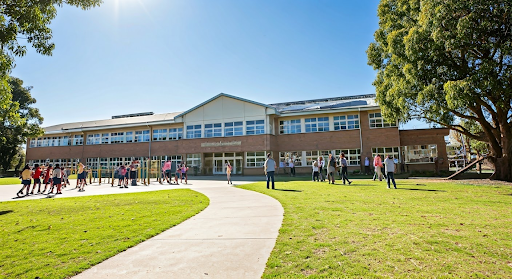Key Highlights
- Starting school is a legal requirement for children aged 6 to 17 in Victoria, with compulsory starting ages.
- Victorian government schools follow a detailed process for enrolment, including the use of a standardised enrolment form.
- Choosing a school requires considering school zones, neighbourhood schools, and proximity to your home.
- Documentation is crucial, involving proof of permanent address, date of birth evidence, and legal statutory declarations.
- Parents can appeal enrolment decisions or seek compassionate placements under exceptional circumstances.
- Specialist schools and reasonable adjustments are available for children with disabilities, ensuring inclusive education.
Introduction
Enrolling your child in school is an important step in their education. If you are looking into the Victorian government school system, it’s important to understand how to enrol clearly. The system makes sure every child can go to a local school in their school zone. But the timelines, requirements, and eligibility rules can seem hard to grasp. By getting ready in advance and following the rules closely, you can make the enrolment process easy and less stressful. Welcome to this guide that aims to simplify school enrolment in Victoria.
Understanding School Enrolment in Victoria
Enrolment in Victorian government schools follows clear rules that ensure fairness and transparency. It begins by finding your local school. This school is the main option for enrolment based on specific school zones.
For first-time enrolments, parents must review important documents, like enrolment forms and proof of where they live. The process focuses on local schools but also offers some flexibility in certain cases. Understanding school enrolment in Victoria can feel overwhelming at first, so let's break down the enrolment process step-by-step to make it easier to understand.
Overview of the enrolment process
The enrolment process for Victorian schools starts with getting the enrolment information pack and the updated application form, along with the updated enrolment form for enrolment. This pack provides detailed information about the main steps, the documents needed, and key dates for enrolling your child in a school year.
Parents should actively ask their local or neighbourhood school about what they need to do for enrolment. Government schools have placement policies to manage enrolments and keep things fair.
For families enrolling their child in a Victorian government school for the first time, they will fill out an enrolment form. This form collects important data about the student. Submitting this form with documents like proof of your child's permanent residential address helps meet the school's placement policy and priority rules. This clear process makes it easier for new families to enrol.
Key steps every parent should follow
First, enrolling parents need to get and fill out the right enrolment form or online application from their school on behalf of both parents. These forms, including a hard copy of the form, are often available as fillable PDFs to make it easier. Make sure all the required fields are filled out correctly to keep your application on track for the next chapter.
Next, you must confirm your residential address to prove you are eligible for the school you chose. You might need to provide documents like a statutory declaration or a residential address check to support your enrolment application and to verify the student’s address.
After you submit the completed forms and any needed documents, the schools will look at the enrolment applications based on the priority orders in the placement policy. Families will then get an enrolment offer, which will reserve your child's spot at the chosen school. If there are any mistakes in your documents, it could slow down or change the outcome, so check everything carefully before you submit.
Determining the Right School
Choosing the right school for your child means thinking about important things like school zones, how easy it is to get there, and the quality of education. You can visit find my school to help determine your options. Victorian government primary schools and secondary schools serve certain areas. This shows which neighborhoods their students come from.
Parents should check out local schools and other choices to learn about their teaching styles and special programs. Visiting the schools and talking with the staff can help you see if they are a good fit. Next, we will talk about what to think about and explain why school zones are very important for families in Victoria.
Factors to consider when choosing a school
Research is an important part of choosing a school that fits your child’s needs. Visit the school buildings, talk to the staff, and share your child’s learning goals. Many schools allow classroom visits, which helps you see their learning space and what they teach.
Think about how close the school is and the school zones. The enrolment rules usually give first choice to families living in certain areas. If you pick a school outside your zone, it may have stricter admission rules.
Also, look at the school’s successes, activities after class, and how they are involved in the community. This will help you find a school that meets your child’s learning needs. Keeping all these things in mind will lead you to a smart and balanced choice.
Importance of school zones in Victoria
School zones play a big role in how families choose schools and who can enroll in Victoria. The government uses these zones to decide which neighborhood school a child will attend, based on how close they live.
If you want to enroll your child in a school that’s outside their zone, it’s important to check if the school has space. Contacting schools early will help you understand your options and make the best choice.
Eligibility Requirements for School Enrolment
To enroll your child in a Victorian government school, you need to meet some requirements. These include age, legal criteria, and documents. Your child must be 5 years old by 30 April in the year they start school, which is the start of Term 2 for some students. They must be 6 years old for their first year of school.
You must provide proof of permanent address and legal documents that confirm your child’s identity. You will also need to submit updated immunisation records. Read on for more details about each requirement.
Age criteria and legal prerequisites
In Victoria, children need to start primary school at age 5 if they turn 5 by April 30 in that school year. The law says they must be enrolled by age 6 and must be in the appropriate year level.
For secondary schools, parents should follow the placement rules through their child’s primary school. Families can also ask for exemptions if there are special reasons for their situation.
To enroll, some legal requirements include court orders for families that are separated and legal documents to show who the carer is. These documents help protect enrolment rights and prevent problems later on.
Documentation needed for enrolment
Effective school enrolment requires complete documents. You need to provide proof of permanent address. This could be a residential address check, statutory declarations, or utility bills.
You also need to have a copy of the form showing your child’s identity, like their birth certificate or passport. If you are enrolling in Victorian government primary schools, Immunisation History Statements are required.
Parents must send these documents safely, along with any health information or legal orders about custody. If any records are missing or incomplete, it could delay your application or lead to more questions from the school.
The Application Process Detailed
The process to apply for Victorian schools begins with getting the latest enrolment forms. These forms are updated for accuracy. First-time applicants must follow privacy standards and placement rules.
This step checks the available spots in schools based on the required supporting documents. Now, let’s look at how to fill out the forms right and solve any problems with your application.
How to correctly fill out enrolment forms
Enrolment forms are available in different formats, including updated fillable PDFs. Parents need to use standard forms that fit with the placement rules.
The form collects information such as date of birth, permanent residential address, and health details. Make sure all fields are filled out correctly and that supporting documents are accurate.
Mistakes when you submit can affect your child's enrolment offer, so check each section carefully. If you need help, reach out to school staff for guidance.
What to do if facing issues during application
If you face problems during the application process, parents should ask for further advice right away. You can find contact details for your neighbourhood school or regional director to help solve issues quickly.
The privacy team takes care of privacy-related forms. They can help if you have worries about sensitive student information.
For special situations, regional Community Liaison Officers are there to help. You can ask them for advice on appeals or policies for alternative placement to deal with unresolved cases.
Conclusion
Navigating the school enrolment process in Victoria can feel hard, but having a clear checklist and knowing the main steps can help your child’s transition. First, you need to find the right school that meets your needs and fits into your local area. Then, gather all the important documents. Each part is important for a successful enrolment. It’s also good to know the eligibility requirements and be ready to handle any issues that may come up during the application. This step is the start of your child's educational journey, so take the time to understand and follow these tips. If you have questions or need help, please reach out for support.
Frequently Asked Questions
Can I enrol my child in a school outside our zone?
Yes, you can apply to schools that are not in your zone for enrolment purposes, but there might not be many spots available. Designated neighbourhood school rules give priority to local kids. If you want to enroll in special cases, please send applications with the required placement information packs as per the department of education guidelines, and talk to the regional director directly.
What are the options if my child has special educational needs?
You can choose specialist schools or make reasonable adjustments in regular schools. Children with disabilities gain from programmes that consider safety concerns, compassionate grounds, individual circumstances, and help from staff. For support, reach out to your local government school.
How does the enrolment appeal process work in Victoria?
Appeals begin at the school level and can go up to the Regional Directors. Enrolment appeals are processed based on the priority order of placement policies. For further information, any sensitive information shared will be managed according to record standards. This ensures fairness and transparency in the decisions made.




































